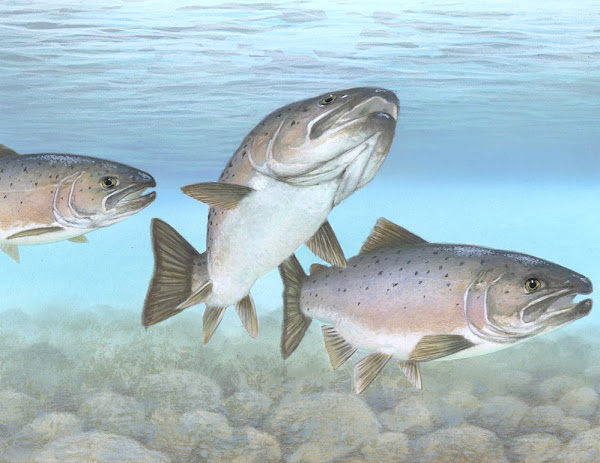The Atlantic salmon is a species of ray-finned fish which is found in the northern Atlantic Ocean. It belongs to the family Salmonidae, and it is mainly found in rivers that flow into the north Atlantic.
This fish has long been the target of recreational and commercial fishing. Excessive fishing and habitat destruction has reduced their numbers significantly. It is the subject of conservation efforts in several countries.
Binomial name of the Atlantic salmon is ‘Salmo salar‘, which derives from the Latin salmo and salar. Salmo means salmon in Latin, and salar means leaper (but more likely meaning ‘resident of salt water).
This fish also known by some other names such as bay salmon, fiddler, outside salmon, black salmon, caplin-scull salmon, silver salmon and sebago salmon. It is also called by many different names at different points in their maturation and life cycle, such as parr, smolt, grilse, grilt, kelt, slink, and spring salmon, And the Atlantic salmon that don’t journey to sea are known as landlocked salmon or ouananiche.
Distribution of the Atlantic salmon depends on water temperature. Some of the specie’s southern populations in Spain and other warm countries are growing smaller, because of climate change.
Today these fish are farmed predominantly in Australia, Canada, Chile, Norway, Ireland, Russia, Tasmania, Faroe Islands and United Kingdom. Read some more information about the Atlantic salmon fish below.
Atlantic Salmon Characteristics
The Atlantic salmon is a beautiful fish. It has a fusiform body, and well-developed teeth. It is the heaviest and longest in genus Salmo. Body coloration of these fish vary depending on the age and water type.
The young fish don’t resemble the color of the mature fish. They have blue and red spots, when they live in freshwater. And they take on a silver-blue sheen at maturity.
The easiest way of identifying them as an adult is by the black spots predominantly above the lateral line. But the caudal fin is generally unspotted.
The males take on a slight green or red body coloration, when they reproduce. All fins, save the adipose, are bordered with black.

Average body length of the Atlantic salmon after 2 years at sea is between 28 and 30 inches. And they can reach between 3.6 and 5.4 kg live body weight.
But the fish that spend 4 or more winters feeding at sea can be much larger and heavier. Photo and info from Wikipedia.
Feeding
Mature Atlantic salmon are feed on arctic squid, sand eels, amphipods, arctic shrimp and sometimes herring.
The young fish begin a feeding response within a few days. They begin to hunt, after the yolk sac is absorbed by the body.
The juveniles start with tiny invertebrates, but they may occasionally eat small fish as they mature. They hunt both in the substrate and in the current during this time.
Even, some have been known to eat salmon eggs. Blackflies, caddisflies, mayflies and stoneflies are the most commonly eaten foods.
Breeding
Most of the Atlantic salmon follow an anadromous fish migration pattern. They undergo their greatest feeding and growth in saltwater. But the adults return to spawn in native freshwater streams.
The eggs hatch and juveniles in the freshwater streams through several distinct stages. They breed in the rivers of Western Europe from northern Portugal north to Norway, Iceland and Greenland.
The Atlantic salmon is iteroparous unlike the various Pacific salmon species which die after spawning. The fish can recondition themselves and return to the sea for repeating the migration and spawning pattern several times.
Uses
The Atlantic salmon is used mainly for food. Is also used for fishing.
Special Notes
The Atlantic salmon are considered prized recreational fish in their natal streams. At one time, the species supported an important commercial fishery and a supplemental food fishery.
The wild Atlantic salmon fishery is commercially dead, after extensive habitat damage and overfishing.
The Atlantic salmon will hybridize with brown trout when they are in shared breeding habitats. Hybrids between Atlantic salmon and brown trout were detected in two of four watersheds studied in northern Spain.
The proportions of hybrids in samples of ‘salmon’ ranged from 0 to 7-7% but they were not significantly heterogeneous among locations, resulting in a mean hybridization rate of 2-3%.
This is the highest rate of natural hybridization so far reported and is significantly greater than rates observed elsewhere in Europe.
This fish still remains a very popular fish for human consumption. And it is generally sold fresh, canned or frozen. However, review full breed profile of the Atlantic salmon fish in the chart below.
| Name | Atlantic Salmon |
| Kingdom | Animalia |
| Phylum | Chordata |
| Class | Actinopterygii |
| Order | Salmoniformes |
| Family | Salmonidae |
| Genus | Salmo |
| Species | S. salar |
| Binomial Name | Salmo salar |
| Other Names | Also known by some other names such as bay salmon, fiddler, outside salmon, black salmon, caplin-scull salmon, silver salmon and sebago salmon. It is also called by many different names at different points in their maturation and life cycle, such as parr, smolt, grilse, grilt, kelt, slink, and spring salmon, And the Atlantic salmon that don’t journey to sea are known as landlocked salmon or ouananiche |
| Breed Purpose | Mainly food, fishing |
| Special Notes | Can survive in both freshwater and saltwater environment, highly priced as food, generally sold fresh, canned or frozen, pretty rare today in it’s native range mainly due to overfishing and climate change, very tasty, popular fish for human consumption |
| Breeding Method | Natural |
| Weight | 3.6 to 5.4 kg |
| Water Type | Both freshwater and saltwater |
| Climate Tolerance | Native climate |
| Body Color | Can vary |
| Rarity | Common |
| Availability | Native range |






